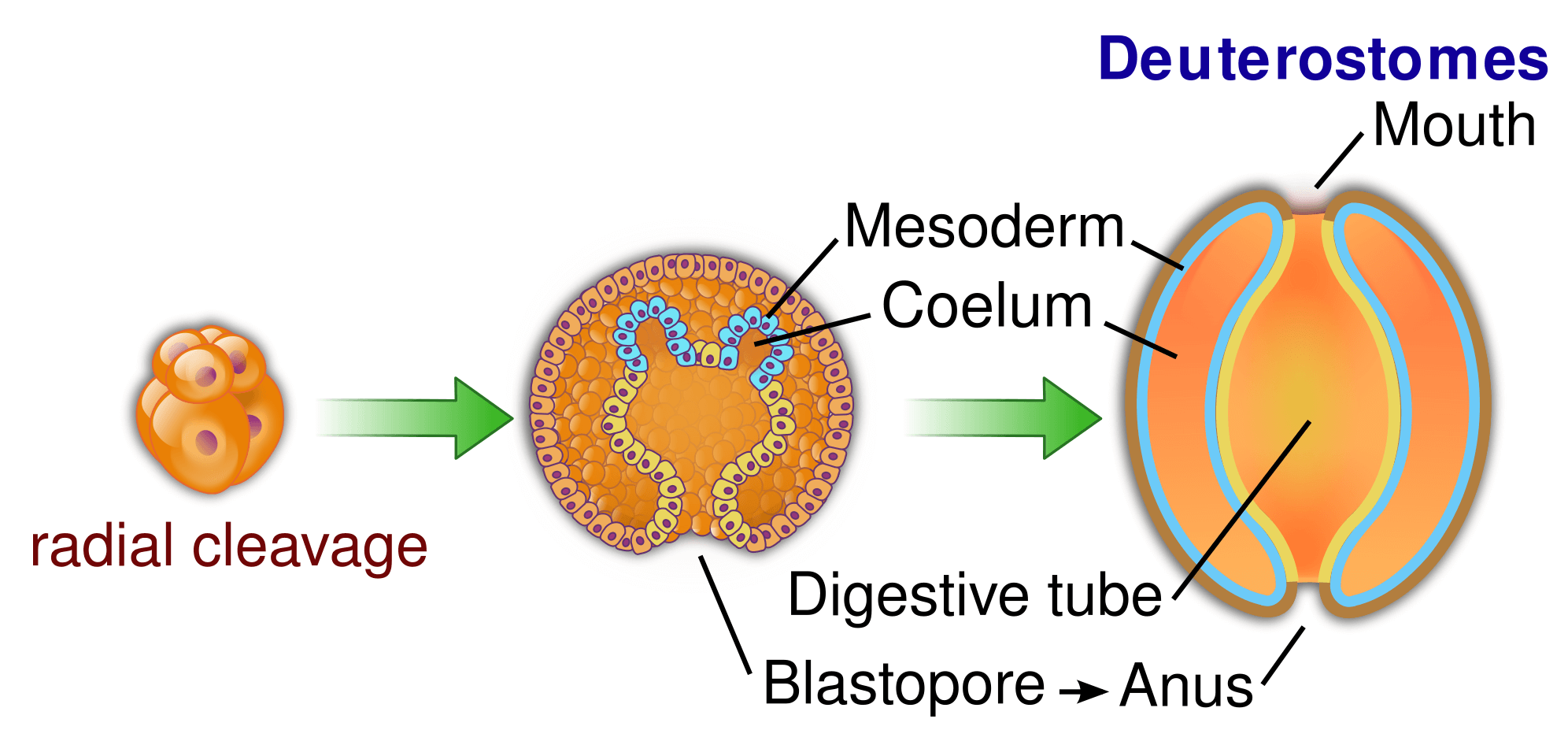Deuterostomes Definition
“Deuterostome” the word means “second mouth”. It is a superphylum of kingdom Animalia grouping together all the animals having bilateral symmetry and the blastopore (the first opening in cleavage) developing into the anus during embryonic development. They include Echinodermata and Chordata.
Download the Complete Guide to NEET UG Prep
Download Now
Deuterostomes Characteristics
- Radial cleavage of the zygote. Here the 4 cells of the zygote undergo parallel and perpendicular division to the original body axis symmetrically

- Indeterminate or regulative cleavage, i.e. the fate of each embryonic cell is not predetermined and can be altered during early embryogenesis if they are moved out to a different location. Each cell has an ability to develop into a complete embryo if they are isolated
- The anus develops from the first cavity formed by blastopore and followed by the formation of mouth on the opposite side. The blastopore is the small indentation in the blastula, which migrates to the opposite end forming the endodermal layer
- Enterocoelom- the coelom formation begins at the gastrula stage of development. The coelom is formed from the fusion of internal outgrowths from the endodermal lining of the archenteron, i.e. the primitive gut. The membrane protrusions pinch off to become the mesodermal layer between ectoderm and endoderm. These coelomic pouches fuse together to form the coelomic cavity
- In egg-laying deuterostomes, the ectoderm is formed from the peripheral cells of the gastrula, which forms the skin, hair and nervous system. Mesoderm present between ectoderm and endoderm forms connective tissues, muscle, skeletal system, kidneys, blood and heart
- In mammals, the blastocyst that is equivalent to blastula forms the placenta and the inner cells develop into three primary germinal layers
Deuterostomes Examples
Phylum Echinodermata
These are marine animals having bilateral symmetry at the larval stage. The adults have radial symmetry. Examples: starfish, sea urchin, sea lily, sea cucumber, etc.
Phylum Chordata
They are characterised by the presence of the notochord, which is replaced by the vertebral column in the vertebrates. There is a presence of dorsal hollow nerve cord and pharyngeal slits. Examples: Fishes, birds, reptiles, amphibians, birds and mammals.
Deuterostomes and Protostomes Difference
Deuterostome is a sister clade of Protostomes. Bilateria is a group under subkingdom Eumetazoa, which has triploblastic animals with bilateral symmetry. On the basis of difference in embryonic development, they are further divided into superphylum, Protostomia and Deuterostomia. These animals are coelomate, i.e. having true coelom but there is a difference in the cleavage of the zygote, fate of blastopore and coelom formation.
| Characteristics | Protostome | Deuterostome |
| The fate of the blastopore | The blastopore develops into a mouth | The blastopore develops into anus |
| Cleavage of the zygote | The cleavage of a zygote is spiral and determinate. The four cells of the embryo undergo oblique cleavage to the original axis and the fate of each of the 8 cells is determined. | The cleavage of the zygote is radial and indeterminate. The four cells undergo cleavage parallel and perpendicular to the body axis and fate of each cell is not determined early and each of the 8 cells has a capacity to act as a clone and can develop into full organism if isolated and developed separately |
| Origin of mesoderm | Mesenchyma cells migrate to form the mesoderm | Ingrowths from archenteron develop into the mesoderm |
| Coelom formation | Schizocoelous- solid masses of mesoderm split to form the coelom, archenteron is not formed | Enterocoelous- folds of the archenteron form the coelom |
| Origin of the second opening mouth/anus | The gut tunnels into embryo forming anus | The gut tunnels into embryo forming the mouth |
| Nervous system | It is represented by a solid, ventral nerve cord | They have a hollow nerve cord and pharyngeal gill slits |
| Larval ciliary bands | Multiciliated cells | Single cilium in each cell |
| Examples | Annelids, Arthropods, Molluscs, flatworms | Echinodermates, Chordates |
This was all about Deuterostomes. For more such topics related to NEET, visit BYJU’S.
Further reading:
- Coelom
- NEET Questions Animal Kingdom
- Difference Between Oviparous And Viviparous Animals
- Important Notes Of Biology For NEET Animal Kingdom
- Flashcards Of Biology For NEET Animal Kingdom
Recommended Video:


Comments